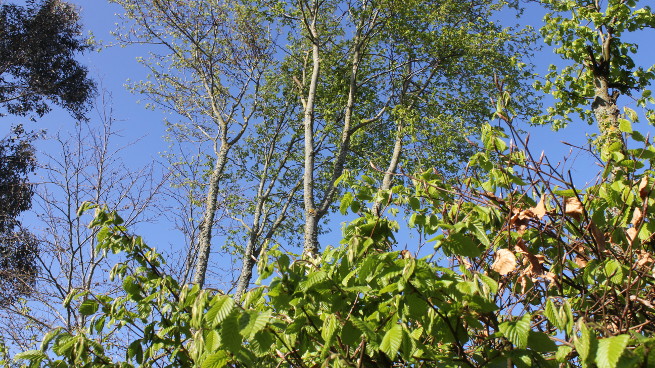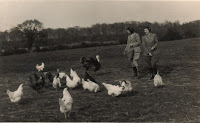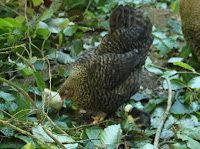'Air meadows' is the beautiful description for a multi millennial old tradition of feeding European livestock. How do we know this? Well because in this form of silviculture, the standard way of growing trees for an optimum harvest was to pollard them and thus create a yearly plethora of thickly growing, thin leafy branches above browse height. Evidence of whole stands of trees pruned this way have been discovered dating from the Neolithic Period all over the continent and there still exist examples of ancient pollarded trees in parks common land and pre-Enclose Act hedgerows.
It is very interesting to note that up until the beginning of the 20th century more tree hay, was cut, dried and stored for use in
Europe than conventional (grass) hay. Furthermore, air meadows didn't just provide food, sheep in particular are known to self-medicate for internal parasites by using the tannins and other phenolic compounds found in leaves. So for free food and medicine, look to the sky.
Pollarding? - Historically A Vexed Question
I have to admit right from the outset that I do not like pollarded trees, I find the practice ugly and quite frankly unsettling. Living in a country where every municipality pollards every tree, I can not fail to be effected by a Winter urban landscape of gnarled and tortured trees, raising their raw bare knuckles to the sky in supplication. Poetry aside however, this is a practice which has been documented in writing since Roman times and was used not only for the feeding of livestock but also for the silviculture of wood for fuel. In the coloured plate left: The illuminated page for February from Les Très Riches Heures du Duc de Berry (1416); we can see a stand of pollarded trees, no doubt crucial for Winter heat and fodder for 'the flock in woolly fold'. Witness the man in the blue coat, pollarding his trees, this was often done with an axe or billhook by the skillful practitioner.
In opposition to this practice below left, in the background of the scene for 'April' witness a stand of trees, not yet in leaf, exhibiting to my mind the true ugliness of the pollard. It was perhaps this offence to the aesthetics of 19th Century England, as well as the need for trees for shipbulding both through increased warfare and trade, that caused the eventual demise of the practice in the country. Other factors involved were the concentration of land ownership, the various Enclosure Acts and the rise of coal as a major fuel source. Another two major causes were; the influence of the new Timber Trade and the gathering sway of celebrity Landscape Gardeners such as Capability Brown and Humphrey Repton, of whom Uvedale Price wrote in 1792:
'...he would deserve a statue if he could inspire Mr Pitt with such an aversion to (stripped elms) as to make him exert his great authority and eloquence to put an end to such a horrid practice’.
Price argued that the ending of pollarding;
‘....would do more towards beautifying the face of England than all the sums that ever have, or will be laid out in improvements’James Main writing in 1839 in his book 'The Forest Planter and Pruner's Assistant' argued that pollarding was akin to ‘mutilation’, ‘distortion’ and ‘bad taste’ and that ‘only natural disbranchement by wind or lapse of time’ could produce a natural shape that could be admired. Looking at some of the horrors of crown pollarding and terrible lopping attempts that disfigure the meadows near me, such as this once majestic oak, left, I'm afraid I have to agree!
Pollarding Protocols
© 2021 Sue Cross
REFERENCES:
Pollarding Trees: Changing Attitudes to a Traditional Land Management Practice in Britain 1600–1900
Online fodder tree database for Europe - Nutritional Values
Fodder trees for improving livestock productivity and smallholder livelihoods in Africa
James Main: The Forest Planter and Pruner's Assistant: being a practical treatise on the management of the native and exotic forest trees commonly cultivated in Great Britain..RELATED ARTICLES
Food For Free Fabulous Forage Part 9 (Air Meadows Part 2) - Tree Choices
Food for Free. Fabulous Forage Part 1 Grass
Food for Free. Fabulous Forage Part 2 Chickweed
Food for Free. Fabulous Forage Part 3 Tree Fodder & Tree Hay
The idea of tree fodder is inextricably linked with the changing landscape, the full domestication of animals, the concept of farming and the clearance of the forests... read more
Food for Free. Fabulous Forage Part 4 Roses for Food & Forest
For me the rose is the quintessential forest garden plant, from canopy to ground cover there are so many to choose from ... read more
Food for Free. Fabulous Forage Part 5 Rose Petals
One of the main roses I use for both cooking, medicinals and which my hens very much enjoy is, not surprisingly, rosa gallica Officinalis, or The Apothecary Rose... read more
Food for Free Fabulous Forage Part 6 Rose Leaves and Hips
For thousands of years the rose, hips, leaves and blossoms have been used as medicinals for both physical and nervous system ailments. .....read more


















Hi again, Sue! Remeber me? I'm the lady with the little rooster named Bruce.
ReplyDeleteI love the pic you posted above of Les Très Riches Heures du Duc de Berry (1416). I blew it up and was really giving it a good look over. Did you notice anything, umm... odd, about the 2 people on the far left sitting in front of the fire? Take a look.
Hi there,
DeleteYes I remember you and your adorable Serama x rooster (starring on my Instructables page 'Do Poultry make Good Pets).
Well I think probably only the rich had undergarments in this era but actually, real Scots, who wear kilts don't wear them either despite the climate. We certainly started the day with a laugh - thanks to you!! I think also this is very much the humour of the Middle Ages too, in re contemporary writers like Chaucer in England.
Much love from Normandie and a Big Hug for Bruce,
Sue xx